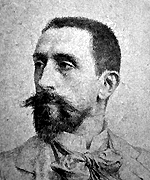BIOGRAPHY - Camille Felix Bellanger (1853 - 1923)

Camille Felix Bellanger was born in Paris in 1853 at the very beginning of the Second Empire, a prosperous era when Napoleon III ruled France, and Baron Haussmann was appointed Prefect of the Seine, a position that allowed him to reshape Paris by creating the wide boulevards and elegant apartment blocks that characterize the city today. It was a time when the Beaux-arts style in both painting and architecture were at their peak. Bellanger’s early life remains obscure, but he was studying at the Ecole des Beaux-Arts by the early 1870s, presumably after the end of the Franco-Prussian War of 1870-71. There is no record of Bellanger’s involvement in the war, although he would have been of an age to perform his military service at the time—and in fact, his later involvement with the military school at St. Cyr tends to support the possibility that he had some background in the French army.
Bellanger’s years at the Ecole des Beaux-Arts were productive. He trained with two of the best-known academic painters of the day, Alexandre Cabanel and William Bouguereau. Cabanel’s influence is clearly visible in the young Bellanger’s 1875 painting, The Death of Abel, which won him a Second Class Medal in the celebrated Prix de Rome [Rome Prize] competition that year. In this youthful image, the twisted nude body of the murdered Abel lies in a rocky landscape, mystically highlighted with a heavenly light. The contrapposto position of the body is technically impressive, albeit reminiscent of Cabanel’s famous image of the Birth of Venus.
During the first stage of his career, Bellanger worked primarily in the Academic style approved by the Ecole. His subject matter was generally religious or mythological with occasional forays into historical genre scenes. Paintings such as The Death of Demosthenes or Chalonidas’ Last Appeal depict heroic figures that sacrificed their lives for their country even in the face of ignorant fellow-citizens. These compositions are organized according to academic tradition, utilizing classical architecture as a backdrop to the unfolding narrative action in the foreground, and rendering the figures in the neo-classical sculptural style of Jacques-Louis David. On a less somber note, Bellanger also painted what might be called historical eroticism, images such as Bacchante, which is fundamentally an image of a beautiful semi-nude woman under that guise of mythological propriety. This type of painting was well within the parameters established by Cabanel’s work, and it typically received great public acclaim at that Salon.
A shift in Bellanger’s subject matter seems to coincide with his acceptance of a post as a professor of drawing at the Ecole Spéciale Militaire de St. Cyr, the elite French military academy founded by Napoleon in 1802. Originally located in Fontainebleau, just outside of Paris, the military academy was moved to St. Cyr in Brittany in 1806. By the late nineteenth century when Bellanger taught there, Brittany had become a popular destination for artists of all sorts; landscape painters who came to capture the rugged coastline and dramatic rock forms; historical genre painters who came to record the lingering traditions of medieval customs such as the Brittany pardons; and modernist painters who gathered around pioneering figures like Paul Gauguin and Emile Bernard. For Bellanger, working at the Ecole Spéciale Militaire offered not only a steady income, but also an abundance of raw material for his painting. For example, Brunette features a solitary peasant woman leaning against a rock wall in the Breton countryside. Dressed in plain clothes and wearing traditional wooden sabots on her feet, she seems to be taking a break from her labors in the field. Like Bouguereau’s solitary figures of Breton women, Bellanger’s brunette is not a weary farm wife, but a slightly disheveled, attractive model posing as a peasant.
In later works, as he became more familiar with the reality of Breton farm life, Bellanger emphasized the arduous nature of the peasant woman’s life. Carrying in the Sheaves of 1920 is one example. Here a beautiful red-haired woman struggles under the weight of the sheaves she is hauling away. Her clothing is no longer a quaint costume, but rather a plain green work dress. In the distance, at the end of a gothic stone-arched passageway, another figure stands next to a simple cart laden with still more sheaves of grain. Just as in his earliest paintings, Bellanger uses light to suggest a mystical glow around the figure, imbuing her with a religious or spiritual status.
During his tenure at the Ecole Spéciale Militaire, Bellanger also wrote an extensive instruction book on painting. Published in 1898 by Garnier frères in Paris, Le peintre: traité usuel de peinture à l'usage de tout le monde, le dessin, figure humaine, perspective, théorie des couleurs, manière de peindre, nature morte, fleurs, glacis, paysages, marine, animaux, etc.... provided direction for all aspects of painting, from basic drawing to color theory and perspective. In addition, the reader could learn about still lifes, landscape, seascape, animal painting, and figure painting. Such a broad scope must have been useful for Bellanger’s students as they mastered drawing and painting skills.
Bellanger’s long dedication to his art, and his continuing success at the annual Salon exhibitions, won additional recognition from the French government in 1911 when he was awarded the Legion of Honor medal. He died twelve years later, at the age of 70, in 1923.
Janet Whitmore, Ph.D.
Museum Collections
Fine Arts Museum of San Francisco
Musée d’Orsay, Paris
National Gallery of Art, London
